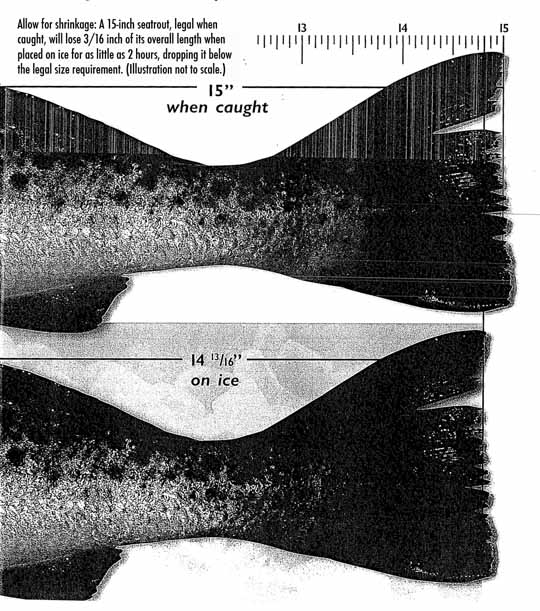
664 Woodville Hwy, Crawfordville, FL 32327 • 850-421-3248 between Tallahassee and St. Marks, FL.

Conservatively Measure Fish to Account
for Shrinkage When Placed on Ice by Tony Murray
Once a legal-size fish is caught, what can you do if the act of placing it on ice causes it to shrink below the legal limits? If the fish was exactly at the legal limit when caught, two hours later (after being placed on ice), the fish would be then under the legal limit, and might possibly put you at risk for penalties if an FWC officer stops to review your catch.
The solution: account for shrinkage when the fish is caught at the legally acceptable limit.
The main variables that have to be taken into account when examining shrinkage are 1) various minimum size limits for the listed species in Florida and 2) how the amount of time fish are placed on ice will affect the amount of shrinkage.
In examining these variables the question was posed to Florida's Fish and Wildlife Conservation Commission (FWC) on how much shrinkage an angler should anticipate. FWC responded that about one percent shrinkage would be a reasonable assumption to begin with for basing calculations.
I assumed this would be for a fish placed on ice for about two hours.
Accurately measuring a fish while on a pitching and rolling boat is more easily said than done. The fish is slippery and wiggling. You've got hooks or lures dangling about you. You are attempting to gently unhook the fish, measure it and get it back in the water unhurt if it doesn't meet the limit. And, you are trying to do all this while the bite is still on. Remember, the officer reviewing your catch will be dealing with a dead fish with not time restraints and may not be attempting to get that extra 1/8-inch in your best interest on a specific measurement.
Proper measuring techniques for a fish involve laying the fish flat and measuring from the forward most point on the head to the rear center edge of the relaxed tail. (Note this is for saltwater species*).
Proper measuring techniques for freshwater fishes are different. For freshwater species the mouth is closed and the tail fin pinched together to obtain measurements. (Note: tails are only pinched for measurement on freshwater species). The FWC web site** presents the best way to obtain this length is to push the fish's snout up against a vertical surface with the mouth closed and the fish laying along a tape measure, then pinch the tail fin closed and determine the total length. Do not pull a flexible tape measure along the curve of the fish.
So, what is this safe rule of thumb when making those calls? For every 10 inches of fish allow for 1/8" shrinkage (which is 1.25%). To further extrapolate this will be 1/4" for 20 inches of fish and 3/8" for 30 inches of fish, and so forth. I used this 1.25 percent shrinkage for this rule of thumb for two reasons. First it conservatively rounds up the one percent FWC referenced and, secondly the .125 decimal form is conveniently equivalent to 1/8 of an inch. A 1/8 of an inch is a reasonable minimum length increment to discern while measuring a fish. As such, 1/8-of-an-inch is the smallest unit of measurement
Accurate for fish that have a fork length requirement: however, many marine fish species are regulated by total length. Billfish and tunas (federally regulated) are measured by lower jaw fork length and curved fork length, respectively.
presented in this article and associated table and all measurements are rounded accordingly.
So, what does this mean for a 15" iced down trout? Mathematically, it means that fish should be 15.15" (which is 15 5/32") when it hits the cooler; practically it means 15 1/8".
What about for an 18" iced down redfish? Mathematically, it means 18.18" (18 11/64") live; practically it means 18 1/4". As in any type of estimating, some numbers will be rolled up and some will be rolled down.
So what does this mean to fish that have an upper slot limit like redfish and snook? "No person shall land, possess, unnecessarily destroy, purchase, exchange, sell or offer for sale...", which means you cannot possess a fish over the slot limit at any time. Icing down a fish in anticipation of it to fit within the slot violates the possession at any time clause.
A California guidance document entitled, To Increase The Chances of a Released Fish Surviving, Anglers Should Use the Following Procedures: circuitously addresses the fish shrinkage issue (http://www.dfg.ca.gov/mrd/releasing.pdf ):
If the length is close to the mark (made on your fishing pole for that species of fish), unhook the fish and compare it to an accurate measuring device. Be advised however, that a prudent angler keeps only fish that are clearly legal as fish can shrink slightly after death. There are no provisions in the regulations that allow for "shrinkage".
Perhaps Florida regulations should actively address this issue, also.
A complete listing of saltwater regulated species with recommended allotment for shrinkage is presented in the adjoining table. This guidance of 1/8-inch shrinkage for each 10 inches of fish and also applies to freshwater species though no chart has been presented because of the extensive area-specific regulations. This rule of thumb also applies in other states and countries in warm water fishery areas though there may be less shrinkage for cold water fish. Carefully measure your catch when that fish is near the minimum legal limit.
Know your size limits and allow for shrinkage of your fish when placed on ice. The rule of thumb: 1/8 of an inch for every 10 inches of fish can be easily remembered on the water.
You are making review of your catch by FWC officers straightforward and quickly and easily performed.
Release those fish that are right on the size limits for catches on future days. You are conservatively protecting your own resources.
Tony Murray is a scientist by trade and an avid saltwater angler.
EDITOR'S NOTE: Regulators and University research personnel are actively addressing fish shrinkage (due to ice) and a follow-up
will be forthcoming. This article was originally published in GAFF magazine and jerrysbait.com has permission of the editors to use it.
It's a fact, fish shrink when placed on ice. Florida Law states that a person shall not be in possession of a fish under the legal size limit; however there is no specific guidance given in Florida regulations to take into account shrinkage of fish when placed on ice. Until now.


and don't forget that this website is supported by:


If you are interested in advertising here, please contact us at 850-421-3248 or email us










Any photograph or other digital image provided to Jerry's Bait & Tackle may be used at the sole discretion of the owners of said establishment and may also be utilized and/or published in other media without prior consent or permission. Neither Jerry's Bait & Tackle nor the owners of said establishment may be subject to any claims for their use of the above-referenced photographs or digital images. Provision of these images is equivalent to consent consistent with the above language.










